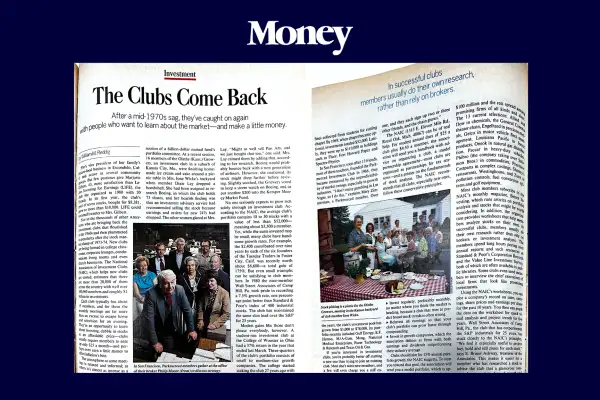Money Classic: Friends Don't Let Friends Invest Alone (1981)

Money is turning 50! To celebrate, we’ve combed through decades of our print magazines to uncover hidden gems, fascinating stories and vintage personal finance tips that have (surprisingly) withstood the test of time. Throughout 2022, we’ll be sharing our favorite finds in Money Classic, a special limited-edition newsletter that goes out twice a month.
This excerpt, featured in the fifth issue of Money Classic, comes from a story in our September 1981 edition.
She's vice president of her family's frozen-food business in Escondido, Calif., and active in several community groups. But few pastimes give Marjorie Gilbert, 43, more satisfaction than Ladies Investing for Earnings (LIFE), the club she organized in 1980 with 20 friends. In its first year, the club's pool of seven stocks, bought for $8,381, grew to more than $10,000. LIFE could not smell sweeter to Mrs. Gilbert.
Nor to the thousands of other Americans who are bringing back the investment clubs that flourished in the 1960s and then plummeted in popularity after the stock market slump of 1973-74. New clubs are being formed in college classrooms, corporate lounges, condominium living rooms and even church basements. The National Association of Investment Clubs (NAIC), which helps new clubs get started, estimates that there are more than 20,000 of them across the country with well over 300,000 members and roughly $1 billion in investments.
Each club typically has about 15 members, and for them the monthly meetings are far more than an excuse to escape home and television for an evening. They're an opportunity to learn about investing, dabble in stocks at an affordable price — clubs usually require members to ante up only $25 a month — and perhaps even earn a little money to offset inflation's bite.
The atmosphere at some meetings is relaxed and informal; at others it's almost as intense as a session of a billion-dollar mutual fund's portfolio committee. At a recent session, 16 members of the Olathe (Kans.) Growers, an investment club in a suburb of Kansas City, Mo., were finishing homemade ice cream and cake around a picnic table in Mrs. Ione Wicke's backyard when member Dixie Lay dropped a bombshell. She had been assigned to research Boeing, in which the club holds 75 shares, and her bearish finding was that an investment advisory service had recommended selling the stock because earnings and orders for the new 747s had dropped. The other women glared at Mrs. Lay. "Might as well sell Pan Am, and we just bought that too," one said. Mrs. Lay calmed them by adding that, according to her research, Boeing would probably bounce back with a new generation of airliners. However, she cautioned, its stock might drop further before reviving. Slightly soothed, the Growers voted to keep a storm watch on Boeing, and to put another $200 into the Kemper Money Market Fund.
No one seriously expects to grow rich solely through an investment club. According to the NAIC, the average club's portfolio contains 18 to 30 stocks with a value of less than $52,000 — meaning about $3,500 a member. Yet, while the sums invested may be small, many clubs have handsome growth rates. For example, the $2,400 contributed over nine years by each of the six founders of the Tuesday Traders in Foster City, Calif., was recently worth about $6,600 — a total gain of 175%. But even small triumphs can be satisfying to club members. In 1980 the nine-member Wall Street Associates of Camp Hill, Pa., took pride in recording a 7.5% growth rate, one percentage point better than Standard & Poor's index of 400 industrial stocks. The club has maintained the same slim lead over the S&P for 25 years.
Modest gains like those don't please everybody, however. A student-run investment club at the College of Wooster in Ohio had a 37% return in the year that ended last March. Three-quarters of the clubs portfolio consists of small to medium-size growth companies. The college started staking the club 27 years ago with fines collected from students for cutting chapel. By 1969, when chapel became optional, investments totaled $52,000. Lately, they were up to $110,000 in holdings such as Fluor, Fort Howard Paper and Spectra-Physics.
In San Francisco, soon after 13 friends, most of them teachers, founded the Parkmerced Investment Club in 1966, they became entranced by the unpredictability of market swings, especially in growth industries. "I don't enjoy gambling in Las Vegas, so I do this," explains Mary Zimmerman, a Parkmerced member. Over the years, the club's investment pool has grown from $1,000 to $78,000. Its portfolio recently included Gulf Energy, E.F. Hutton, M/A-Com, Moog, National Medical Enterprises, Pacer Technology & Research and Texas Oil & Gas.
If you're interested in investment clubs, you're probably better off starting a new one than trying to join an existing club. Most don't want new members, and a few will even charge you a stiff entrance fee — so that your investment will equal those of present members. Founding a club is easy. Explains NAIC chairman Thomas E. O'Hara: "Most begin simply, with two friends deciding to start one, and they each sign up two or three other friends, and the chain grows."
Subscribe to Money Classic here.